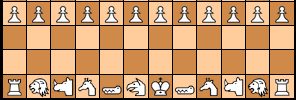[ List Latest Comments Only For Pages | Games | Rated Pages | Rated Games | Subjects of Discussion ]
Comments/Ratings for a Single Item
 . Standard chess with empty extra corner squares and extended castling (with zrf).[All Comments] [Add Comment or Rating]
. Standard chess with empty extra corner squares and extended castling (with zrf).[All Comments] [Add Comment or Rating]The rating is for the castling extension, from fixed up to strict up to loose free castling having been recent topic. The board was invented by King Gustav III of Sweden in 18th Century. Swedish Cannon is another thing entirely and does not appear here. Swedish Cannon is strengthened Xiangqi Cannon by virtue of being able also to jump and slide without capturing. Winther uses the ancient 68-square board a dozen or two times in different piece mixes 'of somewhat the same rules-set'. The last 6 words refer to Winther, like a Fourriere etc., often smartly keeping intact the set RNBK. Winther probably knows his own material enough to find the 25 best from among his over 100 CVs in these CVPage workshops and links.
I haven't tested this extensively, but it has some interesting properties. A weakness on the long diagonal is now much less dangerous. A party could even exchange his fianchetto king's bishop against a knight and escape with the king to the extra square, and even if the opponent has a bishop and a queen on the long diagonal, the king would be protected (provided that the first rank is protected). On the other hand, a weakness along the diagonal to h7 and h2, down to the extra square, is now more dangerous than before. Checkmate must now be more common because the strategy can be less cautious. It's now much more likely that the g-pawn will move two steps. After all, in Fide-chess, this move is generally catastrophic, although one cannot resist doing it in blitz games. This has enormous strategical consequences, and bloody battles on the king's wing will ensue. The extra square could have some significance to the knight, also, as a maneuver square. I have uploaded an update to the Adjutant Chess program which plays better. I also added variants with Chancellor and Archbishop in the extra corners. I am not fond of these pieces (the Amazon is better), but I introduce them so one can compare the virtues of the Gustavian board with Capablanca's Chess and Seirawan Chess. /Mats
 Joe Joyce wrote on Fri, Nov 28, 2008 04:49 PM UTC:
Joe Joyce wrote on Fri, Nov 28, 2008 04:49 PM UTC:Remove both queens. Allow black to choose a piece from queen, chancellor, or archbishop. White then picks from the remaining 2 pieces. It's not a great idea, but it does destroy opening books.
I like this variant; it's a classic 'How close can we be to normal FIDE chess while throwing out the opening book?' variant. Another variant along the same lines that Mr. Winther has proposed is chess 256, where we randomly move a pawn up one square for the eight squares on both sides of the board.
Another idea I like along the same lines is to keep black pieces where they are, but swap White's queen and king. Now, in White's OO move, the king moves right two squares (from the d file to the f file) and the h rook moves left three squares, and in White's OOO move, the king moves left two square (from the d file to the b file) and White's a rook moves right 2 squares to the c file.
Any other ideas for modest chess variants that keep the game the same as much as possible, while throwing out the FIDE opening book?
4 comments displayed
Permalink to the exact comments currently displayed.
